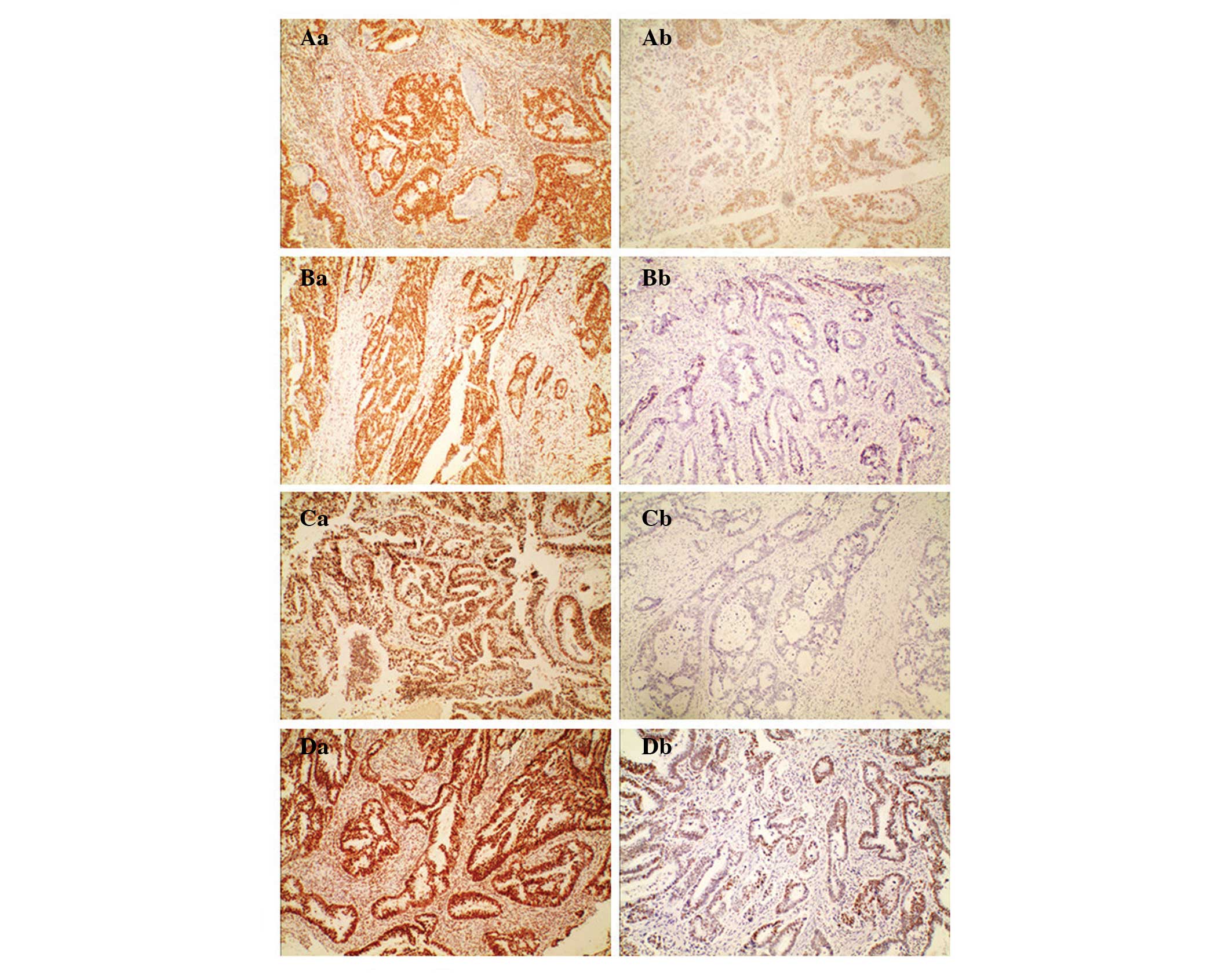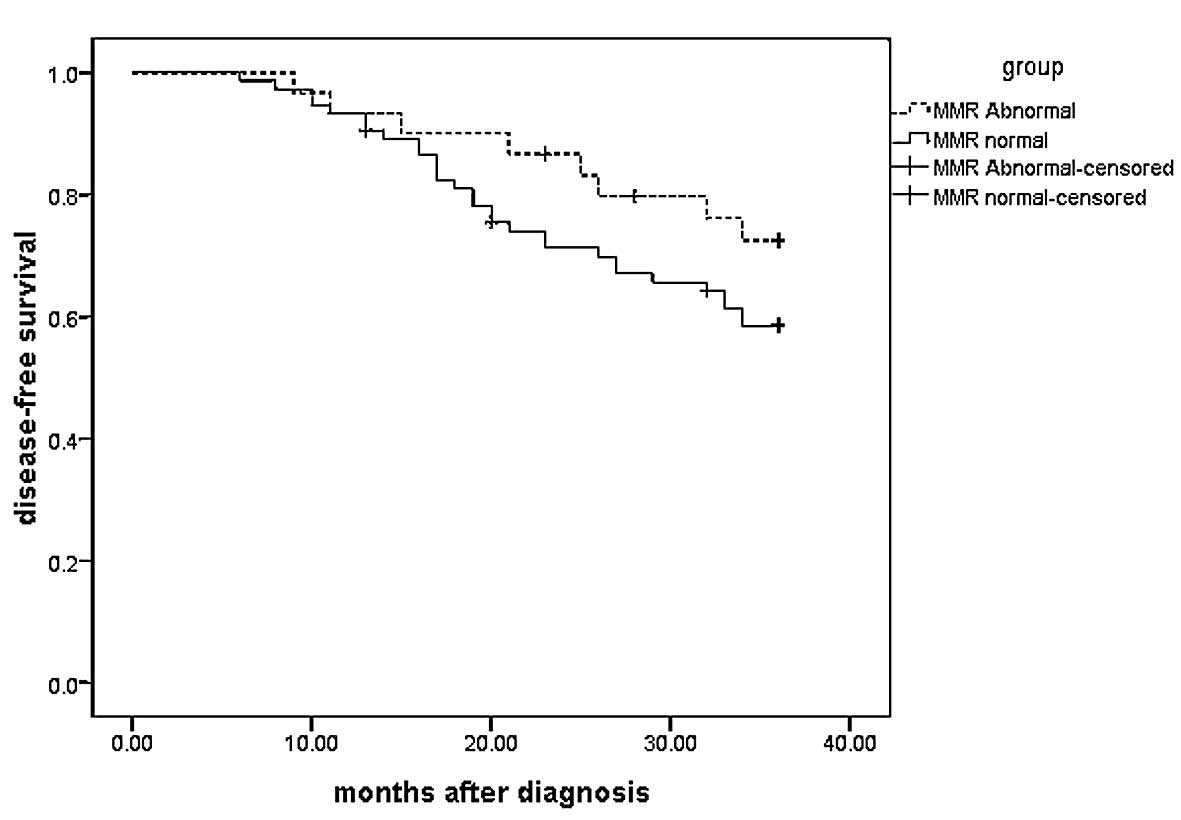|
1
|
Adib SM, Tabbal N, Hamadeh R and Ammar W:
Geographic epidemiology in a small area: cancer incidence in
Baakline, Lebanon, 2000–2008. East Mediterr Health J. 19:320–326.
2013.PubMed/NCBI
|
|
2
|
Van Engeland M, Derks S, Smits KM, et al:
Colorectal cancer epigenetics: complex simplicity. J Clin Oncol.
29:1382–1391. 2011.PubMed/NCBI
|
|
3
|
Blokhuis MM, Pietersen GE, Goldberg PA, et
al: Lynch syndrome: the influence of environmental factors on
extracolonic cancer risk in hMLH1 c. C1528T mutation carriers and
their mutation-negative sisters. Fam Cancer. 9:357–363. 2010.
View Article : Google Scholar : PubMed/NCBI
|
|
4
|
Fishel R, Lescoe MK, Rao MR, et al: The
human mutator gene homolog MSH2 and its association with hereditary
nonpolyposis colon cancer. Cell. 75:1027–1038. 1993. View Article : Google Scholar
|
|
5
|
Aaltonen LA, Salovaara R, Kristo P, et al:
Incidence of hereditary nonpolyposis colorectal cancer and the
feasibility of molecular screening for the disease. N Engl J Med.
338:1481–1487. 1998. View Article : Google Scholar : PubMed/NCBI
|
|
6
|
Mureşan F, Simescu R, Domşa I, et al:
Immunohistochemical screening of hMLH1 and hMSH2 gene mutations in
patients diagnosed with colorectal cancer and microsatellite
instability suspicion. Chirurgia (Bucur). 106:775–780. 2011.(In
Romanian).
|
|
7
|
Wei W, Liu F, Liu L, et al: Distinct
mutations in MLH1 and MSH2 genes in hereditary non-polyposis
colorectal cancer (HNPCC) families from China. BMB Rep. 44:317–322.
2011. View Article : Google Scholar : PubMed/NCBI
|
|
8
|
Rodriguez-Bigas MA, Boland CR, Hamilton
SR, et al: A National Cancer Institute Workshop on Hereditary
Nonpolyposis Colorectal Cancer Syndrome: meeting highlights and
Bethesda guidelines. J Natl Cancer Inst. 89:1758–1762
|
|
9
|
Lynch HT and Smyrk T: Hereditary
nonpolyposis colorectal cancer (Lynch syndrome). An updated review.
Cancer. 78:1149–1167. 1996. View Article : Google Scholar : PubMed/NCBI
|
|
10
|
Win Aung Ko, Young Joanne P, et al:
Colorectal and other cancer risks for carriers and noncarriers from
families with a DNA mismatch repair gene mutation: a prospective
cohort study. J Clin Oncol. 30:958–964. 2012.PubMed/NCBI
|
|
11
|
Wada-Hiraike O, Yano T, Nei T, et al: The
DNA mismatch repair gene hMSH2 is a potent coactivator of oestrogen
receptor alpha. Br J Cancer. 92:2286–2291. 2005. View Article : Google Scholar : PubMed/NCBI
|
|
12
|
Park IJ, Kim HC, Kim JS, et al:
Correlation between hhMLH1/hhMSH2 and p53 protein expression in
sporadic colorectal cancer. Hepatogastroenterology. 52:450–454.
2005.PubMed/NCBI
|
|
13
|
Vreeswijk MP and van der Klift HM:
Analysis and interpretation of RNA splicing alterations in genes
involved in genetic disorders. Methods Mol Biol. 867:49–63. 2012.
View Article : Google Scholar : PubMed/NCBI
|
|
14
|
Sun ZQ, Yu XB, Wang HJ, et al:
Relationship between Aberrant Expression of hMSH2 and prognosis in
patients with sporadic colorectal cancer. Canc Cell Rec. 2:e47–e54.
2014.
|
|
15
|
Belcheva A, Irrazabal T, Robertson SJ, et
al: Gut microbial metabolism drives transformation of
msh2-deficient colon epithelial cells. Cell. 158:288–299. 2014.
View Article : Google Scholar : PubMed/NCBI
|
|
16
|
Cunningham JM, Kim CY, Chirstensen ER, et
al: The frequency of hereditary defective mismatch repair in a
prospective series of unselected colorectal carcinomas. Am J Hum
Genet. 69:780–790. 2001. View
Article : Google Scholar : PubMed/NCBI
|
|
17
|
Ionov Y, Peinado MA, Malkhosyan S, et al:
Ubiquitous somatic mutations in simple repeated sequences reveal a
new mechanism for colonic carcinogenesis. Nature. 363:558–561.
1993. View
Article : Google Scholar : PubMed/NCBI
|
|
18
|
Popat S, Hubner R and Houlston RS:
Systematic review of microsatellite instability and colorectal
cancer prognosis. J Clin Oncol. 23:609–618. 2005. View Article : Google Scholar : PubMed/NCBI
|
|
19
|
Ribic CM, Sargent DJ, Moore MJ, et al:
Tumor microsatellite-instability status as a predictor of benefit
from fluorouracil-based adjuvant chemotherapy for colon cancer. N
Engl J Med. 349:247–257. 2003. View Article : Google Scholar : PubMed/NCBI
|
|
20
|
Sargent DJ, Marsoni S, Monges G, et al:
Defective mismatch repair as a predictive marker for lack of
efficacy of fluorouracil-based adjuvant therapy in colon cancer. J
Clin Oncol. 28:3219–3226. 2010. View Article : Google Scholar : PubMed/NCBI
|
|
21
|
Holzhüter J, Rösch T, Block A, et al: A
44-year-old woman with hereditary nonpolyposis colon carcinoma:
screening examinations for non-colonic tumors. Internist (Berl).
54:353–358. 2013.(In German).
|
|
22
|
Plevová P, Krepelová A, Papezová M, et al:
Immunohistochemical detection of the hMLH1 and hMSH2 proteins in
hereditary non-polyposis colon cancer and sporadic colon cancer.
Neoplasma. 51:275–284. 2004.PubMed/NCBI
|
|
23
|
Lindor NM, Burgart LJ, Leontovich O, et
al: Immunohistochemistry versus microsatellite instability testing
in phenotyping colorectal tumors. J Clin Oncol. 20:1043–1048. 2002.
View Article : Google Scholar : PubMed/NCBI
|
|
24
|
Ruszkiewicz A, Bennett G, Moore J, et al:
Correlation of mismatch repair genes immunohistochemistry and
microsatellite instability status in HNPCC-associated tumours.
Pathology. 34:541–547. 2002. View Article : Google Scholar : PubMed/NCBI
|
|
25
|
Shia J, Klimstra DS, Nafa K, et al: Value
of immunohistochemical detection of DNA mismatch repair proteins in
predicting germline mutation in hereditary colorectal neoplasms. Am
J Surg Pathol. 29:96–104. 2005. View Article : Google Scholar : PubMed/NCBI
|
|
26
|
Marcus VA, Madlensky L, Gryfe R, et al:
Immunohistochemistry for hMLH1 and hMSH2: a practical test for DNA
mismatch repair-deficient tumors. Am J Surg Pathol. 23:1248–1255.
1999. View Article : Google Scholar : PubMed/NCBI
|
|
27
|
Joost P, Veurink N, Holck S, et al:
Heterogenous mismatch-repair status in colorectal cancer. Diagn
Pathol. 9:1262014. View Article : Google Scholar : PubMed/NCBI
|
|
28
|
Haghighi MM, Aghagolzadeh P, Zadeh SM, et
al: Telomere shortening: a biological marker of sporadic colorectal
cancer with normal expression of p53 and mismatch repair proteins.
Genet Test Mol Biomarkers. 18:236–244. 2014. View Article : Google Scholar : PubMed/NCBI
|
|
29
|
Hawkins NJ and Ward RL: Sporadic
colorectal cancers with microsatellite instability and their
possible origin in hyperplastic polyps and serrated adenomas. J
Natl Cancer Inst. 93:1307–1313. 2001. View Article : Google Scholar : PubMed/NCBI
|
|
30
|
Kupčinskaitė-Noreikienė R, Skiecevičienė
J, Jonaitis L, et al: CpG island methylation of the MLH1, MGMT,
DAPK, and CASP8 genes in cancerous and adjacent noncancerous
stomach tissues. Medicina (Kaunas). 49:361–366. 2013.PubMed/NCBI
|
|
31
|
Gomes A, Reis-Silva M, Alarcão A, et al:
Promoter hypermethylation of DNA repair genes MLH1 and MSH2 in
adenocarcinomas and squamous cell carcinomas of the lung. Rev Port
Pneumol. 20:20–30. 2014. View Article : Google Scholar : PubMed/NCBI
|
|
32
|
Molaei M, Mansoori BK, Ghiasi S, et al:
Colorectal cancer in Iran: immunohistochemical profiles of four
mismatch repair proteins. Int J Colorectal Dis. 25:63–69. 2010.
View Article : Google Scholar : PubMed/NCBI
|
|
33
|
Bellizzi AM and Frankel WL: Colorectal
cancer due to deficiency in DNA mismatch repair function: a review.
Adv Anat Pathol. 16:405–417. 2009. View Article : Google Scholar : PubMed/NCBI
|
|
34
|
Valle L, Perea J, Carbonell P, et al:
Clinicopathologic and pedigree differences in amsterdam I-positive
hereditary nonpolyposis colorectal cancer families according to
tumor microsatellite instability status. J Clin Oncol. 25:781–786.
2007. View Article : Google Scholar
|
|
35
|
Jass JR: HNPCC and sporadic MSI-H
colorectal cancer: a review of the morphological similarities and
differences. Fam Cancer. 3:93–100. 2004. View Article : Google Scholar : PubMed/NCBI
|
|
36
|
Raskin GA, Ianus GA, Kornilov AV, et al:
Immunohistochemical examination of MSH2, PMS2, MLH1, MSH6 compared
with the analysis of microsatellite instability in colon
adenocarcinoma. Vopr Onkol. 60:47–50. 2014.(In Russian).
|
|
37
|
Kim JH and Kang GH: Molecular and
prognostic heterogeneity of microsatellite-unstable colorectal
cancer. World J Gastroenterol. 20:4230–4243. 2014. View Article : Google Scholar : PubMed/NCBI
|
|
38
|
Goldstein J, Tran B, Ensor J, et al:
Multicenter retrospective analysis of metastatic colorectal cancer
(CRC) with high-level microsatellite instability (MSI-H). Ann
Oncol. 25:1032–1038. 2014. View Article : Google Scholar : PubMed/NCBI
|
|
39
|
Slattery ML, Levin TR, Ma K, et al: Family
history and colorectal cancer: predictors of risk. Cancer Causes
Control. 14:879–887. 2003. View Article : Google Scholar : PubMed/NCBI
|
|
40
|
Campbell PT, Cotterchio M, Dicks E, et al:
Excess body weight and colorectal cancer risk in Canada:
associations in subgroups of clinically defined familial risk of
cancer. Cancer Epidemiol Biomarkers Prev. 16:1735–1744. 2007.
View Article : Google Scholar : PubMed/NCBI
|
|
41
|
van Duijnhoven FJ, Botma A, Winkels R, et
al: Do lifestyle factors influence colorectal cancer risk in Lynch
syndrome? Fam Cancer. 12:285–293. 2013.PubMed/NCBI
|
|
42
|
Botma A, Nagengast FM, Braem MG, et al:
Body mass index increases risk of colorectal adenomas in men with
Lynch syndrome: the GEOLynch cohort study. J Clin Oncol.
28:4346–4353. 2010. View Article : Google Scholar : PubMed/NCBI
|
|
43
|
Win AK, Dowty JG, English DR, et al: Body
mass index in early adulthood and colorectal cancer risk for
carriers and non-carriers of germline mutations in DNA mismatch
repair genes. Br J Cancer. 105:162–169. 2011. View Article : Google Scholar : PubMed/NCBI
|
|
44
|
Sánchez-de-Abajo A, de la Hoya M, van
Puijenbroek M, et al: Molecular analysis of colorectal cancer
tumors from patients with mismatch repair proficient hereditary
nonpolyposis colorectal cancer suggests novel carcinogenic
pathways. Clin Cancer Res. 13:5729–5735. 2007.
|
|
45
|
Karoui M, Tresallet C, Brouquet A, et al:
Colorectal carcinogenesis. 1. Hereditary predisposition and
colorectal cancer. J Chir (Paris). 144:13–18. 2007.(In French).
|
|
46
|
Bubb VJ, Curtis LJ, Cunningham C, et al:
Microsatellite instability and the role of hhMSH2 in sporadic
colorectal cancer. Oncogene. 12:2641–2649. 1996.PubMed/NCBI
|
|
47
|
Gryfe R, Kim H, Hsieh ET, et al: Tumor
microsatellite instability and clinical outcome in young patients
with colorectal cancer. N Engl J Med. 342:69–77. 2000. View Article : Google Scholar : PubMed/NCBI
|
|
48
|
Sankila R, Aaltonen LA, Järvinen HJ and
Mecklin JP: Better survival rates in patients with hMLH1-associated
hereditary colorectal cancer. Gastroenterology. 110:682–687. 1996.
View Article : Google Scholar : PubMed/NCBI
|
|
49
|
Heinimann K, Scott RJ, Buerstedde JM, et
al: Influence of selection criteria on mutation detection in
patients with hereditary nonpolyposis colorectal cancer. Cancer.
85:2512–2518. 1999. View Article : Google Scholar : PubMed/NCBI
|
















